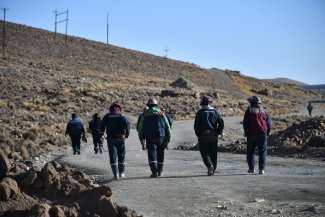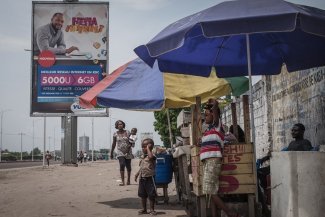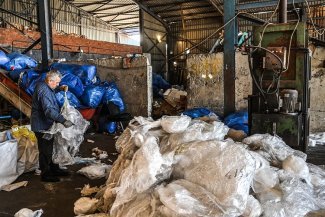Afghan refugees near Belgrade’s central station try to stay warm. Since 2016, thousands of migrants and refugees have been stranded in Serbia as the Balkan migration route into western Europe is now blocked. Many of them are unaccompanied minors.
When 14-year-old Sadiq left his hometown in Afghanistan, he was expecting a much easier journey to Europe. “My family told me that it would only take 15 or 20 days,” he says.
Eight months later, having travelled several thousand miles through Iran, Turkey and Bulgaria, he is now in Serbia.
The young teenager faced this incredibly perilous journey to Europe alone.
Sadiq admits to being disheartened by the amount of time his journey has taken. “I feel like I am stuck here.” He has tried to cross the border to Hungary on more than five occasions. Each time, he has been arrested, beaten, stripped of his belongings and sent back to Serbia.
“The Hungarian border police have dogs,” Sadiq tells Equal Times, after a paltry meal made of lentils and bread he and six other friends cooked over a small open fire. “I got bitten every time.”
According to the latest figures from the United Nations High Commissioner for Refugees (UNHCR), there are approximately 7,700 refugees and migrants in Serbia.
While 85 per cent of them are accommodated in government-run facilities across the country, Sadiq is one of the 1,200 people from Afghanistan and Pakistan currently stranded in the area surrounding Belgrade’s central station, in a makeshift camp known as "the barracks’’ – a complex of abandoned warehouses, with no running water, power or medical facilities.
Those living in the barracks have been stranded there for months, since the Balkan migration route into the European Union was effectively shut in 2016.
Until recently, Turkey was the main gateway into mainland Europe for refugees fleeing war-torn countries such as Syria, Iraq and Afghanistan, or others escaping political oppression and economic instability from Iran and Pakistan for example, via Balkan countries such as Macedonia, Serbia and Bulgaria.
But following the signing of a controversial deal between the EU and Turkey in March 2016, which allows for the return of all refugees and migrants who pass through Turkey to prevent them from staying on or attempting to reach the EU, Hungary, Croatia and Slovenia have reinforced their border control efforts, thus effectively closing the Balkan migration route.
As a result, refugees and undocumented migrants who enter Serbia now run the risk of getting trapped in Serbia, a country which currently has no resettlement plan and which UNHCR does not consider a “safe third country” for asylum seekers.
A third under the age of 18
Sadiq is also one of the many unaccompanied minors living in the abandoned warehouses. UNHCR estimates that around a third of the barracks’ population are children or young people under the age of 18 – some are even as young as 12. Save the Children say that as many as 100 new refugees and migrants are arriving every day. Forty-six per cent of them are children, 20 per cent of that figure are unaccompanied.
Children as young as six are trying to survive in sub-zero temperatures as low as -15°C, amidst severe food shortages and almost no assistance from the Serbian government.
While Save the Children, UNHCR and Médecins Sans Frontières (MSF) are working with a handful of Serbian NGOs to offer the refugees and migrants relief, not enough is being done.
“On a normal day, we see around 100 patients,” says Andrea Contenta, a humanitarian affairs officer for MSF in Belgrade. “Around 40-45 per cent of them are minors.”
Amongst the minors who visit the MSF clinic located just a few hundred metres from the barracks, scabies and chest infections are the most common afflictions.
“That is the direct result of being left in an unsanitary, undignified space, without the possibility to have a shower for months,” Contenta explains.
Respiratory illnesses are also incredibly common due to the fires refugees light up inside in a desperate bid to stay warm. Constant coughing can be heard throughout the camp. Cases of frostbites are frequent too.
“We are in central Belgrade, in the centre of Serbia, in 2017. These conditions are not acceptable,” Contenta adds.
“Every day is the same thing”
For Belgrade’s homeless refugees, every morning starts by putting an oil drum of freezing water on an open fire. People then take turns to wash themselves: sinking in mud on the warmer mornings; wading through inches of snow when the Serbian winter hits the hardest.
It takes just a few hours in the barracks to spot them: young faces covered in dirt, crouched around a fireplace, beside a tent or wrapped up in blankets. In the barracks, children are everywhere.
“Every day is the same thing,” says Leiaquat, an 11-year-old from Jalalabad, Afghanistan. “I wake up. We make a fire. We sit around the fire. We eat. We sleep.”
Leiaquat fled his hometown to escape the intense fighting between the local offshoot of the so-called Islamic State and the Taliban.
As he talks to Equal Times, Leiaquat and a friend are trying to revive last night’s fire. Wood is hard to come by and so people burn whatever they can get their hands on – plastic, clothes, railway beams, blankets. Leiaquat is trying to burn a ski boot.
Visibility is almost zero as other countless morning fires burn steadily.
“The Taliban don’t let us go to school,” he says, explaining why he fled Afghanistan. “I want to go to school in Europe and become a doctor,” he adds, adjusting the scarf he keeps tied around his head to stay warm.
He began his journey with a cousin, he explains. “We crossed into Iran and Turkey together. But he was arrested in Turkey and sent back to Afghanistan.”
Leiaquat had to continue alone, first towards Bulgaria. There, his group was caught by border police. “They took our clothes and shoes and they sent us back to Turkey,” he recalls.”We had walked six days in the woods to get there.”
Leiaquat tried a second time and finally crossed into Serbia. He now sleeps in one of the main warehouses, in an improvised shelter built from scrap wood. It’s hardly enough to protect his young body from the cold air coming in from what used to be a loading bay but it’s better than sleeping outside.
Leiaquat shares his ‘bunk’ with a friend, another Afghan boy, age 12. His face is soot-smugged from the many days and nights spent indoors, where smoke fills every room.
“Cigara..?” Leiaquat’s friend asks.
I shake my head to signal that I have no cigarettes with me. He manages to get one from a fellow refugee. He sticks it in his mouth, lights it up and goes back to the fire.
Failed policies
“The main point is that there is no definite census of the unaccompanied children living in the barracks,” MSF’s Contenta says, commenting on what’s being done to accommodate the significant presence of child refugees.
Under the Convention of Rights of the Child – of which Serbia is a signatory – “unaccompanied and separated children outside their country of origin” are guaranteed the protection of their rights by the state.
Yet, the reality on the ground is a different one.
“The lack of proper screening has resulted in the lack of proper response. In government camps, children have no access to formal education, for example. In some camps, the spaces are not adequate or equipped to receive minors.”
For Contenta, however, things are gradually changing. Support from the Serbian government to accommodate refugees is increasing.
Last month, the Serbian Commissariat for Refugees opened a new centre in Belgrade, giving priority to unaccompanied minors.
But more needs to be done, he says. “There is the need for a comprehensive plan that involves regional powers and the EU in order to rethink the EU policy on migration. [What is happening in] Belgrade is the result of the failure of those policies.”
To see Matteo Congregalli’s short video documentary on The Lost Boys of Belgrade, click here.










